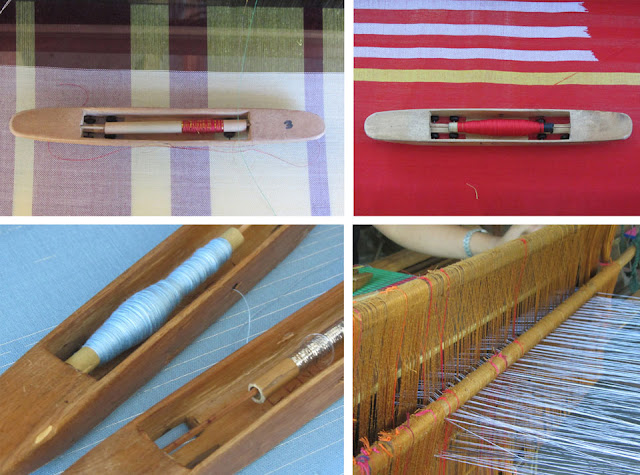Narra trees, dwarfs and bravery
Located inside the Pagsanga-an Elementary School in the
town of Pavia is a narra tree believed to be enchanted.
Just like its “residents” which are dwarfs, the tree is
just 4 meters tall as measured from the ground to its first branch while its
trunk is 2.7 meters in diameter.
Susan Jovero, municipal planning officer, said that the
tree became popular in September 1988 when news broke out that dwarfs were seen
swaying to and fro its branches. Because of this, people from different places
flocked to the area to offer food and flowers.
Based on testimony by a native of the place, Rowena
Jeco, the tree already existed when the school was constructed in 1949.
The tree has not grown tall despite its age because it
was struck by a lightning in 1978, leaving it almost dead. But it grew again.
 |
Clockwise: Narra trees of Pavia, Sta. Barbara, Cabatuan
and Leganes
|
THE ONE THAT SAVED LIVES. Meanwhile, the narra tree located in Brgy. Calaboa Elementary School in Leganes, Iloilo was a favorite hiding place of government soldiers whenever they had an encounter with rebels of the New People’s Army.
“The NPA rebels passed by this area in the 1970’s. The
school was not around yet then,” said Wilson Batislaong, municipal environment
officer of Leganes. “This tree has saved many lives,” he added. It has a circumference of 3.7 meters.
A SYMBOL OF HISTORY. Meanwhile, the Manuel L. Quezon Tree
of Cabatuan, Iloilo stands proud in front of the town’s municipal hall to
remind people of a historic event.
According to the Cabatuan Environment and Natural
Resources Office (MENRO), this narra tree, which has a circumference of 3.55
meters, was planted in 1933 when then Senate President Manuel Luis Quezon
became the first Philippine Commonwealth President and when Tomas Confesor was
appointed as the Filipino Director of Commerce by Governor General Theodore
Roosevelt Jr.
Confesor, an Ilonggo, was called by former president
Teofisto Guingona was a “fighter until the end” because he fought against the wrong
political systems.
 |
Buttress of the century-old narra tree in Brgy. Lanupe, Nueva Valencia Guimaras. Other photo shows Antonio Genisan, whose father was 17 years old when the tree was only 35 inches in circumference. |
A FAMILY’S LEGACY. Situated in a family compound in Sitio
Sapa, Brgy. San Antonio, San Miguel, Iloilo is a 35-year-old narra tree that
has withstood typhoons and floods.
Gilbert Rosal Bernadas planted it in 1978 when he was 17
years old because it can give him a shed, a nest for the birds, good lumber and
source of medicine.
Now aged 53 years old, Bernadas has not cut the tree and
he has allowed it to spread its branches.
 |
Narra tree in San Miguel, Iloilo with the search’s judges and barangay officials |
UNTOUCHED IN THE WILD. Meanwhile, at the watershed of Ubog
Spring in Brgy. Lanupe, Nueva Valencia, Guimaras stands a centennial tree with
a circumference of 6 meters.
Antonio Genisan, 59 and caretaker of the Ubog Spring,
said that his father told him that it was already there when he was 17 years
old. His father died 10 years ago at the
age of 83 years old.
According to the provincial environment and natural
resources office, the tree is believed to be enchanted, thus, no one has dared
cut its branches.
Individuals passing by the area say to the unseen “Tabi,
tabi”, meaning, “let us pass”.
 |
First row: Oton National High School, Quarry area in San
Miguel; second row: Cabatuan Municipal Hall, Pagsanga-an Elem. School in Pavia; and third row: Sta. Barbara Plaza, Leganes Lagoon
|
TREE PROTECTION. Meanwhile, the Oton National High School’s
narra tree has a circumference of 3.8 meters.
Leticia Ramos, 84; and Virginia Hidalgo, 85; residents of
Brgy. Poblacion North, Oton, Iloilo said that the narra tree, among others, was
planted inside the school in 1946; they estimate it is 67 years old.
To protect their narra trees, the barangay council created
an ordinance last February 2013 wherein violators will be fined P300 for the
first offense, P600 for the second offense and P1,000 for the third and
subsequent offense.
HAIRY GIANT. The Sta. Barbara town plaza has several
narra trees and one of them is popularly called the “hairy giant” due to the
vines that grow on its trunk and branches.
However, Department of Environment and Natural Resources
Office forester Grepa Gallego said that although these vines are beautiful,
they are parasites that steal the nutrients that the narra tree needs to become
better.
It is approximately 30 years old, tall and with branches
and leaves evenly spread.
 |
Guimaras. First row: Guimaras Express, Spring water flows to a container; second row: Stream, bolo making; third row: At the jetty port and children of Brgy. Lanupe, Nueva Valencia, Guimaras
PROTECTION AND CONSERVATION. The narra tree or
“Pterocarpus indicus” is the Philippines’ national tree.
It has medicinal properties such as anti-cancer,
anti-diabetes, anti-HIV and anti-infection. It also helps in removing urinary
stones, it burns fat and relieves joint pains.
The tree is protected by Republic Act 9147 or the
Wildlife Resources Conservation and Protection Act of March 20, 2011.
The abovementioned trees are entries in the search for
the Biggest, Sturdy and Beautiful Narra Tree among the MIGEDC (Metro Iloilo
Guimaras Economic Development Council) member municipalities. Iloilo City is
also a member of MIGEDC.
The
narra trees were judged last December 16 and 17 based on the following
criteria: Diameter or size of the tree (measured from the ground to its first
branch), 25%; bole formation (free from rot or defect), 25%; crown formation
(should be healthy and vibrant in overall appearance and has even distribution
of branches and twigs), 25% and age of the tree, 25%.
Three
winners will be announced next year, the date of which will be set.
They
winners will receive; first prize, P15,000; second prize, P10,000; and third
prize, P5,000./




